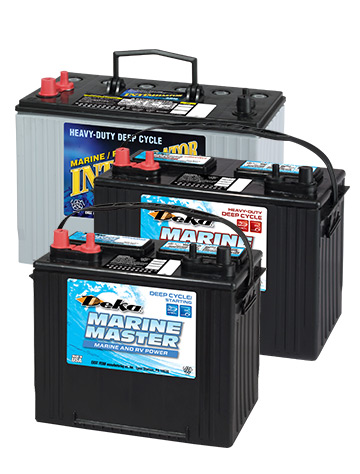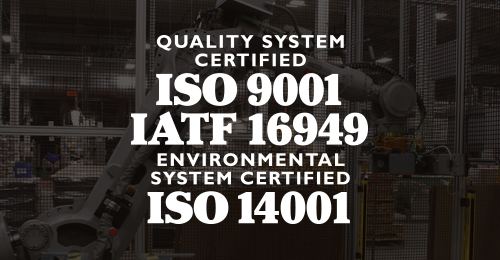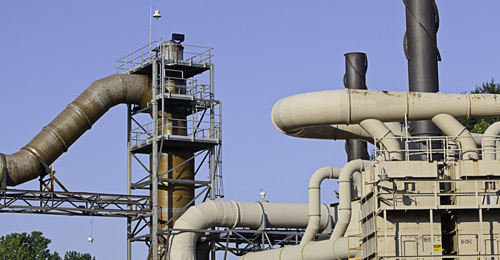Recreational Vehicles
Solid and Reliable
Ordinary automotive batteries aren’t designed to handle the deep-discharge accessory power that RVs demand. Reliable RV travel depends on batteries from East Penn – the ultimate power solution for your home away from home.
Recreational Vehicle Batteries:
Learn more about East Penn’s battery selection for recreational vehicles and the difference between flooded, AGM, and Gel technology.
Marine Master Marine and RV Flooded Batteries
Marine Master® Marine and RV Flooded Batteries offer the ultimate power solution for your home away from home.
Features
Heavy-Duty Deep Cycle – True Deep Cycle Service
- More power for electronic accessories
- Built-in protection against deep discharge damage
- Rugged vibration-resistant construction
- Reliable power for modest starting
Deep Cycle/Starting – The Best of Both Worlds
- High starting and deep cycle capability
- Longer cycling than starting battery
- Extra reserve power for accessory loads
- Rugged vibration-resistant construction
Additional Resources
Intimidator AGM Series
The Intimidator AGM battery series will never be intimidated by the power demands of today’s complex RVs.
Features
- Over 2x the cycle life* withstands demands of heavy house power
- 20x more vibration resistant* for extensive travel protection
- Best all-purpose service provides starting, cycling, and deep cycle capability
- Safer install and transport with no-spill design to prevent acid leaks
- High freeze-resistance provides better all-weather performance
- Better capacity protection during periods of infrequent use
*Above and beyond conventional designs
Additional Resources
Deka Dominator Gel Series
The Deka Dominator’s unique gelled electrolyte technology offers some of the deepest cycling batteries in the RV industry.
Features
- Longest deep cycle life
- Ultimate performance for heavy house power
- Superior protection against vibration and deep cycle damage
- Better capacity protection during periods of infrequent use
- Safer install and transport with no-spill design to prevent leaking acid
- Dependable starting performance
Additional Information
Distribution
With over 90 warehouses and distribution centers in North America, East Penn is here to service your delivery and core return needs through one powerful network.
Whether it’s store-door or direct delivery programs, our network of company-owned and operated facilities and premier sales and service staff delivers the industry’s leading logistical support and highest customer satisfaction levels.
Technologies
East Penn is one of the only battery manufacturers to make all types of flooded, AGM (Absorbed Glass Mat), and Gel technologies. This gives customers a powerful choice and reliable information source for these lead-acid battery products.
We also offer the exclusive UltraBattery® and Synergy technologies for partial state-of-charge transportation applications. UltraBattery technology combines the advantages of an Advanced VRLA battery with the advantages of an asymmetric supercapacitor, while our Synergy battery technology offers one of the most cost-effective solutions that is ideal for Micro or Mild HEVs.
Resources & Downloads
- Marine/RV Battery Care & Maintenance Brochure (0273)
- Guide to VRLA Batteries (1927)
- Warranty Information
If you’re unable to find what you’re looking for, please feel free to contact us.
FAQs
East Penn’s POWER-PERFORM Ⓡ PLATES
Why are East Penn’s Power-Perform Ⓡ Plates more efficient than other plates?
The plate plays a critical role in the performance of the battery’s overall power system. The ability of the plate to store and deliver power is directly proportional to how well it supports the vehicle’s power needs. Power-Perform Plates perform these functions with the highest efficiency enabling more power-per-space and better overall performance.
• Full-frame structure provides better current transfer from all sides of the plate
• Enhanced crystallization of the active material and specially formulated oxide optimizes energy storage for high-powered performance
• Low resistance current path grids with more top frame intersecting wires allow the direct flow of energy for greater starting power
• Revolutionary paste adhesion techniques deliver better performance over extended use
How do East Penn’s Power-Perform Plates Ⓡ perform better while lasting longer?
Power-Perform Plates work within an overall battery life protection system and an advanced durability design to extend performance and service life.
• Increased grid frame tensile strength resists plate growth to safeguard against life-threatening shorts
• Thicker backweb and puncture resistant separators prevent plate-to-plate electrical shorts
• Ultra-pure electrolyte with no impurities inhibits unnecessary water loss
• Full-frame plate structure prevents exposed wire electrical shorts
• Advanced battery formation controls prevent high temperature damage and under-formed, low-performance plates
Precision craftsmanship, stringent testing, and consistent performance and quality analysis through advanced centralized laboratories ensure that Power-Perform Plates deliver optimized life, power, and durability, even under the most severe service. This means lower warranty claims due to less defects combined with better and longer battery performance.
AGM (Absorbed Glass Mat) TECHNOLOGY
What is AGM?
AGM stands for Absorbed Glass Mat
What is an Absorbed Glass Mat?
A highly absorbent, micro-porous mat made of special glass fibers. The specially designed mats are an essential component in the battery’s electrolyte suspension system. All of the electrolyte is absorbed into this material enabling a spillproof design.
Why buy an AGM battery from East Penn?
East Penn is a pioneer in developing the Form, Fit, and Function of AGM battery technology. The company’s engineering design and manufacturing process meets major US and European OE automotive manufacturers’ standards. From the company’s use of the finest raw materials to precision-focused manufacturing (like the weighing and thickness analysis of every battery group), East Penn’s AGM battery design and process has been tested and proven to best meet the Form, Fit, and Function criteria of the automotive industry.
Are AGM batteries OK for any application?
AGM batteries will replace a flooded battery in any typical alternator voltage regulated system. These systems generally maintain a voltage at 13.8 to 14.4 volts (cars, trucks, commercial trucks, boats, etc.). In fact, the efficient recharging of the AGM battery design can cause less wear on the vehicle’s alternator system over time.
Can AGM batteries be recycled like conventional flooded batteries?
AGM and conventional flooded lead-acid batteries are one of the most recyclable products on the planet. Lead-acid batteries have a higher recycling rate than glass, aluminum, and newspaper. In fact, virtually 100% of every battery component can be recycled to make a brand new battery. East Penn operates one of the most modern and environmentally-safe facilities in the world. This enables our customers to assure their customers that they are recycling their batteries with someone they can trust.
Is AGM really a premium battery product?
Yes. This advanced AGM technological design offers superior performance over conventional flooded batteries. All automotive batteries are expected to meet a certain level of performance standards for engine starting and to provide reserve power for the vehicle’s electronics. AGM batteries, however, are expected to excel in certain key aspects of battery use such as:
1. CYCLING PERFORMANCE
2. SEVERE SERVICE DURABILITY
3. DEEP DISCHARGE RESILIENCY
4. VIBRATION RESISTANCE
As the electrical, high heat, severe service, and durability demands continue to intensify for today’s vehicles, conventional flooded batteries may not deliver the dependable performance and service life needed under these conditions. This is not only the trend for cars and trucks, but now commercial trucks, marine vessels, and power sports vehicles are requiring a more evolved type of battery power.
1. CYCLING PERFORMANCE
Why do customers need better cycling performance from their batteries?
Today’s vehicles, and those to come, are being built with more factory-installed electronics and more places to plug in portable devices. For example, cars and other passenger vehicles have to provide power for items like LCD viewers, GPS systems, stereos and speakers, powered windows or doors, cell and smart phone charging, and anything else that plugs in or turns on. Boats need power for accessories like live-wells, GPS systems, stereos, hazard lighting, fish finders, and any other item that plugs in or turns on. Cars that utilize stop/start functions, like Micro Hybrid Electric Vehicles, demand extra durability and a better charge acceptance from their battery. As more types of electric vehicles evolve, so will the need for a higher cycling tolerance from the battery.
How do AGM batteries help to deliver better cycling performance?
AGM battery technology withstands these additional accessory power and cycling demands while still having the power to start the vehicle. An AGM battery’s enhanced durability and charge acceptance makes it an essential component for many stop/start and other electrical system technology. Its ability to have over twice the cycle life of a conventional flooded design gives it a clear advantage for its implementation into progressing electric vehicle technology.
2. SEVERE SERVICE DURABILITY
Why do customers need better severe service durability from their battery?
Severe service and higher temperature conditions continue to escalate because there is less open space under-the-hood with more demand on the battery. Also, more vehicles undergo stop-and-start driving conditions, further increasing the need for enhanced durability.
How do AGM batteries help deliver better severe service durability?
AGM battery technology can be utilized to help offset these increasing power and durability demands. The AGM battery’s ability to withstand severe service and accessory power demands under elevated temperatures and stop-and-go conditions will better safeguard performance and extend battery life.
3. DEEP DISCHARGE RESILIENCY
Why do customers need a better deep discharge resiliency from their battery?
Vehicles that aren’t used everyday have a higher risk of not starting because of parasitic accessory power loads. Parasitic loads, or even leaving something on when the ignition is off, can completely drain the battery’s power.
How do AGM batteries help deliver better deep discharge resiliency?
AGM battery technology delivers a higher deep discharge abuse tolerance. This helps protect the battery longer from situations like infrequent use, parasitic power drains, or other deep power discharge (like leaving your vehicle’s lights on when the ignition is off).
4. VIBRATION RESISTANCE
Why do customers need a battery that resists vibration damage?
Vibration resistance is extremely important to protecting the battery’s life in almost any application that moves. Vibration or jolting movements can lead to electrical shorts or the loss of electrical storage capacity that can significantly decrease the battery’s performance.
How do AGM batteries help deliver battery vibration resistance?
AGM technology utilizes an Absorbed Glass Mat that protects the battery’s internal components. These special separators serve as a shock absorber to the battery, which buffers vibration or other potentially damaging movement. This added vibration protection is especially ideal for off-road vehicles, watercraft, performance cars, tuner cars, or any other vehicles that undergo intense vibration during normal use.
CYCLE LIFE IN AGM BATTERIES
What is Cycle Life?
A CYCLE is a single occurrence when energy is taken out of the battery and then put back in. CYCLE LIFE is the ability of the battery to do that over and over again and continue to deliver reliable performance.
How does claims of extended CYCLE LIFE differ from claims of just extended battery life?
LIFE vs. CYCLE LIFE
Claims that a battery has extended LIFE could simply mean it survives longer than average in a typical automotive application in an average climate. In the real world, actual battery life is highly variable and unpredictable. The stresses on a battery differ by climate, vehicle differences, and user habits. A battery may last a long time under ideal conditions, but fail with only minimal abuse.
A battery with extended CYCLE LIFE survives longer than average under more grueling demands that portray a more realistic picture of real world use. This includes warmer climates, higher under-hood temperatures, longer than typical hours of usage, higher annual miles of operation, and frequent electrical loads while the engine is off.
Why do customers need better cycling performance from their batteries?
Today’s vehicles, and those to come, are being built with more factory-installed electronics and more places to plug in portable devices. For example, cars and other passenger vehicles have to provide power for items like LCD viewers, GPS systems, stereos and speakers, powered windows or doors, cell and smart phone charging, and anything else that plugs in or turns on. Boats need power for accessories like live-wells, GPS systems, stereos, hazard lighting, fish finders, and any other item that plugs in or turns on.
Newer cars are also utilizing additional electronic functions in areas that were traditionally powered by the engine. This is not only the case for Hybrid Electic Vehicles, but is also being incorporated throughout a variety of standard automotive designs. These additional electronic services demand extra performance from the battery. As more types of vehicles evolve further into electrification, so will the need for the higher cycling tolerance and overall durability in a battery that can be found in the AGM design.
How does East Penn’s AGM product have extended CYCLE LIFE?
East Penn’s AGM batteries have special glass mats that are strategically wrapped around the battery’s power producing components. The main reason for this mat is to absorb all the battery’s acid so the battery won’t leak or spill if turned over or if cracked. However, these mats also provide an added layer of protection for these components. This added protection enhances the battery’s durability against continual power drains like electronics. In fact, East Penn’s AGM batteries have 2x the cycle life over traditional maintenance-free flooded batteries to power more accessories for much longer. This enhanced durability also protects the battery from vibration, high temperatures, the rigors of stop-and-go driving and frequent vehicle use.
VRLA AGM AND GEL BATTERIES
What are VRLA batteries?
Valve-Regulated Lead-Acid or VRLA, including Gel and AGM (Absorbed Glass Mat) battery designs, can be substituted in virtually any flooded lead-acid battery application (in conjunction with well-regulated charging). Their unique features and benefits deliver an ideal solution for many applications where traditional flooded batteries would not deliver the best results. For almost three decades, East Penn has been manufacturing valve-regulated batteries using tried and true technology backed by more than 65 years experience. East Penn produces a complete line of Gel, AGM, and conventional flooded products for hundreds of applications. This diverse product offering enables East Penn to be objective as to the advantages of each type of battery. East Penn’s VRLA (Gel and AGM) products have the reputation of being the highest quality VRLA batteries available.
How do VRLA batteries work?
A VRLA battery utilizes a one-way, pressure-relief valve system to achieve a “recombinant” technology. This means that the oxygen normally produced on the positive plate is absorbed by the negative plate. This suppresses the production of hydrogen at the negative plate. Water (H2O) is produced instead, retaining the moisture within the battery. It never needs watering, and should never be opened as this would expose the battery to excess oxygen from the air. In addition to damaging the battery, opening it also voids the warranty.
What is the difference between VRLA batteries and traditional flooded batteries?
Flooded electrolyte batteries do not have special one-way, pressure-relief valves, as they do not work on the recombination principle. Instead, flooded designs utilize a vent to allow gas to escape. They contain liquid electrolyte that can spill and cause corrosion if tipped or punctured. They should not be used near sensitive electronic equipment.
They can only be installed “upright.” Flooded batteries lose capacity and become permanently damaged if:
• Left in a discharged condition for any length of time (due to sulfation). This is especially true of designs that require water maintenance.
• Continually over-discharged (due to active material shedding). This is especially true of automotive starting types.
What are ideal applications for VRLA batteries?
Deep Cycle, Deep Discharge Applications
• Marine Trolling
• Electronics
• Sailboats
• Electric Vehicles
• Wheelchairs/Scooters
• Golf Cars
• Portable Power
• Floor Scrubbers
• Personnel Carriers
• Renewable Energy
• Village Power (Solar, Wind)
• Marine & RV House Power
• Commercial Deep Cycle Applications
Standby and Emergency Backup Applications
• UPS (Uninterrupted Power Systems)
• Cable TV
• Emergency Lighting
• Computer Backup
• Renewable Energy
• Frequency Regulation (Solar, Wind)
• Telephone Switching
Other Applications
• Race or High Performance Cars
• On-Highway Trucking
• Off-Road Vehicles
• Wet Environments
• Marine & RV Starting
• Diesel Starting
• Cars and Light Trucks
• Vehicles with with Accessories
• Start-Stop Systems
What are Gel and AGM batteries?
VRLA technology encompasses both gelled electrolyte or gel batteries and absorbed glass mat or AGM batteries. Both types are regulated by special one-way, pressure-relief valves and have significant advantages over flooded lead-acid products.
AGM (Absorbed Glass Mat) batteries
The electrolyte in AGM batteries is completely absorbed in separators consisting of matted glass fibers. This causes them to be spillproof, meaning they don’t leak acid like a flooded design if tipped on their side. The glass mats in AGM batteries are wrapped around the positive plate, which helps prevent damage from vibration and extend cycling. The battery’s groups are packed tightly in the case partitions also protecting its power producing components. AGM battery designs can have over twice the cycle life of a conventional flooded product in the right application.
Gel or Gelled Electrolyte batteries
The electrolyte in a Gel battery is permanently locked in a highly viscous gelled state instead of the traditional liquid form. Because there is no liquid-type electrolyte, it will not leak out of the battery if tipped on its side. The thick, gelled electrolyte and tightly packed groups also protect the battery’s power producing components. Gel battery designs have a superior deep discharge resiliency and can deliver over two to three times the cycle life of an AGM product in the right applications.
What are some similarities between Gel and AGM batteries?
Batteries utilize special one-way, pressure-relief valves and must never be opened.
• Requires no electrolyte maintenance unlike deep cycle flooded batteries that require frequent checking and adjustment of electrolyte levels.
• Uses a recombination reaction to prevent the escape of hydrogen and oxygen gases normally lost in a flooded lead-acid battery (particularly in deep cycle applications).
• Spillproof design enables installation in virtually any position (upside-down installation is not recommended).
• Has a higher tolerance against damage from deep discharge. These batteries have optimized amounts of electrolyte (which is also referred to as “acid-starved”) so that they use the power in the acid before they use the power in the plates. This minimizes the destructive nature of ultra-deep discharges. Ultra-deep discharging is what causes plate shedding, which can destroy a battery.
What are the Major differences between Gel and AGM battery performance?
A Gel battery is better suited for super-deep discharge applications, which means it can withstand deeper discharges without damaging the battery’s performance. However, due to the physical properties of the gelled electrolyte, Gel battery power declines faster than an AGM battery as the temperature drops below 32ºF (0ºC). AGM batteries excel for high current, high power applications and in extremely cold environments. AGM batteries deliver a better dual purpose solution for a combination of starting and accessory power.
What are the advantages of GEL and AGM battery designs?
(waiting on image)
What do I need to know about VRLA battery charging?
All lead-acid batteries release hydrogen from the negative plate and oxygen from the positive plate during charging. VRLA batteries have one-way, pressure-relief valves. Without the ability to retain pressure within the cells, hydrogen and oxygen would be lost to the atmosphere, eventually drying out the electrolyte and separators.
Voltage is electrical pressure (energy per unit of charge). Charge (ampere-hours) is a quantity of electricity. Current (amperes) is electrical flow (charging speed). A battery can only store a certain quantity of electricity. The closer it gets to being fully charged, the slower it must be charged. Temperature also affects charging. If the right voltage is used for the temperature, a battery will accept charge at its ideal rate. If too much voltage is used, charge will be forced through the battery faster than it can be stored.
Reactions other than the charging reaction also occur to transport this current through the battery—mainly gassing. Hydrogen and oxygen may be given off faster than the recombination reaction. This raises the pressure until the one-way, pressure-relief valve opens. The gas lost cannot be replaced. Any VRLA battery will dry out and fail prematurely if it experiences excessive overcharging.
Note: It is too much voltage that initiates this problem, not too much charge — a battery can be “over-charged” (damaged by too much voltage) even though it is not fully “charged.” Never install any lead-acid battery in a sealed container or enclosure. Hydrogen gas must be allowed to escape.
Can continual undercharging harm a VRLA battery?
In many respects, undercharging is as harmful as overcharging. Keeping a battery in an undercharged condition allows the positive grids to corrode and the plates to shed, dramatically shortening life. Also, an undercharged battery must work harder than a fully charged battery, which contributes to short life as well.
An undercharged battery has a greatly reduced capacity. It may easily be inadvertently over-discharged and eventually damaged.
Do VRLA batteries have a “memory” like Ni-Cad batteries?
One of the major disadvantages of nickel-cadmium (Ni-cad) batteries is that after shallow discharge cycles, the unused portions of the electrodes “remember” the previous cycles and are unable to sustain the required discharge voltage beyond the depth of the previous cycles. The capacity is lost and can only be restored by slowly discharging completely (generally outside the application), and properly recharging. VRLA lead-acid batteries do not exhibit this capacity robbing effect known as memory.
What are the safety precautions for VRLA batteries?
Although all valve-regulated batteries have the electrolyte immobilized within the cell, the electrical hazard associated with batteries still exists. Work performed on these batteries should be done with the tools and the protective equipment listed below. Valve-regulated battery installations should be supervised by personnel familiar with batteries and battery safety precautions.
Protective Equipment
To assure safe battery handling, installation and maintenance, the following protection equipment should be used:
• Safety glasses or face shield (Consult application specific requirements)
• Acid-resistant gloves
• Protective aprons and safety shoes
• Proper lifting devices
• Properly insulated tools
Procedures
Consult user manual of specific application for safety & operating requirements. The following safety procedures should be followed during installation: (Always wear safety glasses or face shield.)
1. These batteries are sealed and contain no free flowing electrolyte. Under normal operating conditions, they do not present any acid danger. However, if the battery jar, case, or cover is damaged, acid could be present. Sulfuric acid is harmful to the skin and eyes. Flush affected area with water immediately and consult a physician if splashed in the eyes. Consult MSDS for additional precautions and first aid measures.
2. Prohibit smoking and open flames, and avoid arcing in the immediate vicinity of the battery.
3. Do not wear metallic objects, such as jewelry, while working on batteries. Do not store un-insulated tools in pockets or tool belt while working in vicinity of battery.
4. Keep the top of the battery dry and clear of all tools and other foreign objects.
5. Provide adequate ventilation as regulated by Federal, State and Local codes and follow recommended charging voltages.
6. Extinguishing media: Class ABC extinguisher. Note: CO2 may be used but not directly on the cells due to thermal shock and potential cracking of cases.
7. Never remove or tamper with pressure-relief valves. Warranty void if vent valve is removed.
Can VRLA batteries be installed in sealed battery boxes?
NO! Never install any type of battery in a completely sealed container. Although most of the normal gasses (oxygen and hydrogen) produced in a VRLA battery will be recombined and not escape, oxygen and hydrogen will escape from the battery in an overcharge condition (as is typical of any type battery).
These potentially explosive gasses must be allowed to vent to the atmosphere and must never be trapped in a sealed battery box or tightly enclosed space!
Does depth of discharge affect cycle life?
Yes! The harder any battery has to work, the sooner it will fail.
The shallower the average discharge, the longer the life. It’s important to size a battery system to deliver at least twice the energy required, to assure shallow discharges.
Follow these tips for the longest life:
• Avoid ultra-deep discharges. The definition of ultra-deep discharge may vary with application and battery type.
• Don’t leave a battery at a low stage of charge for an extended length of time. Charge a discharged battery as soon as possible.
• Don’t cycle a battery at a low state of charge without regularly recharging fully.
Use the highest initial charging current available (up to 30% of the 20-hour capacity per hour) while staying within the proper temperature-compensated voltage range.
What is a thermal runaway?
The appropriate charge voltage depends on the battery temperatures. A warmer battery requires a reduced voltage. If the voltage is not reduced, current accepted by the battery increases. When the current increases, the internal heating increases. This can rise to destructive levels if not taken into consideration.
Thermal runaway can be prevented with:
• Temperature compensation monitoring at the battery —not at the charger.
• Limiting charging currents to appropriate levels.
• Allowing for adequate air circulation around the batteries.
• Using timers or ampere-hour counters.
• Using smart chargers that recognize the signature of a thermal runaway event which will shut the charger down.





